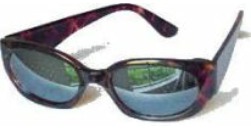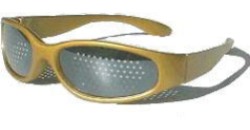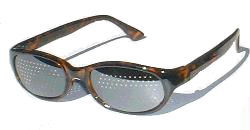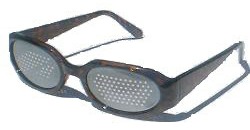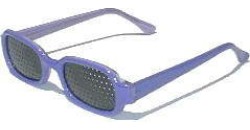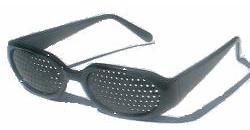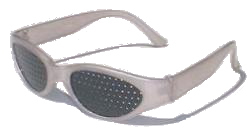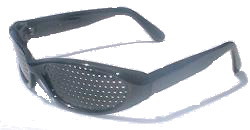With our wide selection of Modern and Traditional Designs, you can decide what “look” to wear with your Pin Hole Glasses.
All of our pinhole glasses include FREE US SHIPPING (and $30 outside of the US).
Get a 5% discount on orders of 4 pairs!
We carry a wide selection of Modern and Traditional myopia pin hole glasses for adults as well as kids. Modern pin holes are generally more stylish—like sunglasses. Traditional pin holes are simpler and lower priced. Both types are equally effective.
Look through our selection of Modern and Traditional Pin Hole Glasses below.
Many people who’ve used pin hole glasses—for even a short time—comment on how more relaxed their eyes feel and how they can see more clearly. At the same time, pinhole glasses aren’t for everyone.
Pin Hole glasses work according to a relatively simple principle, discovered hundreds of years ago. Conventional Pin Hole lenses are made from opaque plastic material with small pinholes in the material. (Modern Design Pin Hole Glasses, such as the St. Bart’s above, use a similar principle, but without physical holes in the lens.) The user looks through these small holes in the material. These holes have the effect of reducing the part of the light rays coming from a viewed object, thereby contributing to improving vision acuity.
The figure below is a schematic representation of a bundle of light rays coming from an object in front of a myopic (nearsighted) eye. Improper refraction, or “bending”, of the outermost rays (dotted lines) in that bundle of light by the eye is a cause of refractive errors such as myopia, hyperopia (farsightedness), presbyopia (diminished focusing range with age) and astigmatism. Pin Hole glasses can bring about clearer vision in all these conditions.
Referring to the figure and the representation of a pinhole in front of the eye: by the lens blocking the outermost rays and allowing only the central rays (solid lines) to pass into the eye, a refractive error in the eye’s lens or cornea is not as pronounced. In other words, the eye’s pupil may be wide open, but only its central portion is receiving light. The improvement in visual acuity in this case can be considerable. This principle, employed in Pin Hole glasses, is found in many other applications, including the well-known pinhole camera, used widely in photography in the past.
An easy way to demonstrate this effect yourself is to make a fist, and put it up to one eye, while closing the other eye. Open your fist just enough to create a small hole to look through. If your eye has a refractive error, you should see more clearly this way.
A similar vision improvement occurs “naturally” when we squint to see somewhat more clearly. The squinting eyelids block the rays that would normally enter the top and bottom of the pupil, in a manner similar to that shown in the figure above. However, since squinting doesn’t serve to cut off rays entering the sides of the pupil, these rays may still contribute to a blurred image. By looking through Pin Hole glasses, instead of squinting, peripheral rays are blocked from all sides.
For those in their 40’s and 50’s-and older
-
- Presbyopia (inability to focus close) develops during these years. Pin Hole glasses provide a simple and inexpensive alternative for reading or other close work.
- Some bifocals and trifocals glasses are designed to provide a clear image only at fixed distances. Pin Hole Glasses provide an improved image at ALL distances. In many applications, such as alternating between watching TV and reading, they can easily take the place of relatively expensive prescription lenses.
- Multi-focal lenses provide a continuously variable focal curve that is intended to allow good vision at all distances. In reality, distortion on either side of the multi-focal center line can be considerable and may be too great for comfortable use. Pin Hole Glasses do not exhibit this problem.
- Some people with cataracts see better through Pin Hole Glasses. A cataract is one or more opacities in the eye’s lens that do not allow the light to pass through properly, but instead cause it to scatter. By blocking off the peripheral rays, Pin Hole glasses aid to reduce some of this scattering and thereby provide a sharper image.
Cost and Advantages versus Most Prescription and Reading Glasses
Pin Hole Glasses are considerably cheaper than prescription glasses. For example, a person who is slightly nearsighted but needs only a correction for clear distant vision for occasional TV viewing could find Pin Hole glasses a significantly cheaper solution than prescription glasses.
- There is no need to continually throw away old glasses and buy new, stronger ones. Unless the Pin Hole Glasses are damaged, they can be used an entire lifetime.
- Off-the-rack reading glasses have the same lens power in each lens. Some people find inexpensive off-the-rack reading glasses inappropriate because the refractive error in each eye is not the same. Pin Hole Glasses are useful for such people because pinholes do not address a similar refractive error in each eye.
- There can be a distortion or a “pincushion effect” seen when looking through the edges of prescription glasses-meaning straight lines appear curved. This disturbing effect is not present with Pin Hole Glasses.
- Many people who have undergone corneal surgery find that their night vision has been permanently deteriorated. Glare is a problem. These people see halos and “starbursts” around lights. Many of these people even feel uncomfortable with normal home lighting—so they get into the habit of turning on as many lights as possible. Brighter light allows their pupils to dilate (become smaller) which can reduce their visual discomfort. Pin Hole glasses can afford the same net effect-but without increasing the electric bill!
Kids and Pin Hole Glasses
Even though using bifocals or reading glasses is a well-known technique for dealing with progressive myopia in kids, many parents won’t purchase bifocals or reading glasses for their children to reduce the stress of close work because such glasses are considered only for “old people.” Pin Hole Glasses are much cheaper than bifocals and can be more readily worn by kids because they are the same for all ages-and because they are “fun”!
Children with special visual needs often use only their peripheral vision, and Pin Hole Glasses help them concentrate on detail better. It has been found that the Pin Hole Glasses help improve acuity and central macular vision. One nationwide organization that deals in child development uses Pin Hole Glasses on a regular basis for this purpose.
Getting used to Pin Hole Glasses
When Pin Hole Glasses are first worn, the wearer may be aware of the series of “open” pinholes and the opaque material between them. (Pass your mouse over the photo on the left to see the pinhole pattern.) This is called the “honeycomb effect”:
Most people adapt to the use of Pin Hole Glasses immediately. For some people–particularly those with little refractive error (“small prescription”)—adaptation to Pin Hole Glasses is fast and the initial honeycomb effect is virtually unnoticeable.
However, the larger refractive error you have (larger prescription) the more this effect may be present. While Pin Hole Glasses block the rays of light outside each pinhole, rays which do pass through the openings can still contribute to blurred vision if a person’s refractive error is great enough. In fact, people who have over 6 diopters of nearsightedness may find Pin Hole Glasses impractical due to this effect.
With that said, adaptation to Pin Hole Glasses is similar to using a new pair of glasses or to the initial wearing of bifocals or multifocal lenses and getting used to the way images seems to change as you move your eyes and or head about. Most people feel more comfortable initially when viewing objects further away. When looking at a TV—as opposed to reading or performing close work, for example—the effect is less pronounced, since your eyes are focused further away.
Do’s and Don’ts with Pin Hole Glasses
-
- Sunglasses—yes! Pin Hole glasses serve to reduce glare and can serve well as sunglasses. In addition to the light reduction provided by the pinholes, they have built-in UV protection, especially the Modern Designs. So you get a sunglass effect and better vision at the same time, with no need for expensive prescription sunglasses. As with any sunglasses, you should never look directly into the sun wearing Pin Hole glasses.
- Computer viewing glasses—yes! Many people experience eyestrain from viewing a computer monitor for long periods. This has been given the name “Computer Vision Syndrome” and it expresses itself in problems such as fatigue, headache, dry eyes, eyestrain, blurred vision and double vision. If you are looking for a way to reduce the visual stress of prolonged work at a computer, Pin Hole glasses may offer an optimal solution and at a much lower cost than other options. Glare from above or the sides is reduced by looking through the lenses. Depth of field can increase. Also, the focusing effort of the eyes, known as “accommodation”, is reduced, just as if you had worn a pair of reading glasses.
- Do NOT wear Pin Hole glasses when driving or when you are in any situation where good peripheral vision is essential. Because the pinhole effect serves to limit peripheral vision, Pin Hole glasses are most suitable for activities such as sitting indoors and outside, reading, computer work, and watching TV.
Pinholes cannot replace prescription glasses in every situation. As noted above, people with over 6 diopters of myopia will probably not find pinholes useful, because pinholes cannot eliminate all of the blur in this case. And just as it would be risky to wear ordinary glasses in situations where they could be broken and damage the eyes, there are situations where using pinholes instead of prescription glasses is not advisable. Use common sense and only wear the pinholes when the limited peripheral vision does not pose a risk.
One group that should not use pinholes, or any glasses that reduce accommodation (focusing effort), is young people who are very farsighted. These people need to accommodate as much as possible in order to reduce their farsightedness to a lower level. This is nature’s dynamic method of refining visual acuity in the growing youngster and it should not be defeated.
-
Modern Designs: for Adults and Kids
Modern Designs all have mirror finishes—meaning the pinhole pattern is not seen by others. The glasses shown below have been photographed with lighting from behind to show the pinhole pattern.
Antigua
FOR KIDS and ADULTS
with small to average head size
| Dimensions | 5.2″ wide, 6″ long |
| Lens | Mirror-coated Acrylic |
| Weight | 1 ounce (28 gr.) |
| Frame color | Gold |
| Frame style | Wraparound “Grip Type” |
| Frame material | Nylon |
| Hole Size | 1.2 mm |
| Space between holes | 2.0 mm |
Tobago
FOR ADULTS with average head size.
Similar to Tortolla, but with rounder lenses.
A favorite with ladies.
| Dimensions | 5.25″ wide, 5.75″ long |
| Lens | Mirror-coated Acrylic |
| Weight | 1 ounce (28 gr.) |
| Frame color | Dark Tortoise Shell |
| Frame style | Standard Temples |
| Frame material | Acetate |
| Hole Size | 1.2 mm |
| Space between holes | 2.0 mm |
Tortolla 
FOR ADULTS
with average head size
| Dimensions | 5.25″ wide, 5.75 ” long |
| Lens | Mirror-coated Acrylic |
| Weight | 1.25 ounce (36 gr.) |
| Frame color | Tortoise Shell |
| Frame style | Standard Temples |
| Frame material | Acetate |
| Hole Size | 1.2 mm |
| Space between holes | 2.0 mm |
St. Barts
FOR MEN and WOMEN
with average head size and
FOR KIDS with larger head size.
| Dimensions | 5.5″ wide, 6″ long |
| Lens | Mirror-coated Acrylic |
| Weight | 1 ounce (28 gr.) |
| Frame color | Matte Black (no shine) |
| Frame style | Wraparound with spring hinge |
| Frame material | Polycarbonate |
| Hole Size | 1.2 mm |
| Space between holes | 2.0 mm |
Traditional Designs: for Adults and Kids
Aruba
FOR ADULTS
with small to average head size and FOR KIDS.
| Dimensions | 5″ wide, 4.75″ long |
| Lens | Plastic |
| Weight | 1 ounce (28 gr.) |
| Frame color | purple |
| Frame style | Standard |
| Frame material | Mixed Acetate |
| Hole Size | 1.1 mm |
| Space between holes | 2.5 mm |
Nevis
FOR ADULTS
average head size.
| Dimensions | 5.3″ wide, 5.5″ long |
| Lens | Plastic |
| Weight | 1 ounce (28 gr.) |
| Frame color | Shiny Black |
| Frame style | Standard Temples |
| Frame material | Acetate |
| Hole Size | 1.1 mm |
| Space between holes | 2.5 mm |
Bonaire
FOR KIDS
or for adults with small-to-average head size.
| Dimensions | 5″ wide, 5″ long |
| Lens | Nylon |
| Weight | .5 ounce (14 gr.) |
| Frame color | Beige |
| Frame style | Standard |
| Frame material | Acetate |
| Hole Size | 1.1 mm |
| Space between holes | 2.5 mm |
Saba
Saba Glasses have been DISCONTINUED.
| Dimensions | 5.3″ wide, 5.5″ long |
| Lens | Plastic |
| Weight | 1 ounce (29 gr.) |
| Frame color | Shiny Black |
| Frame style | Wraparound |
| Frame material | Acetate |
| Hole Size | 1.2 mm |
| Space between holes | 2.5 mm |
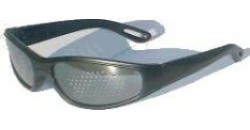 Pin Hole glasses work according to a relatively simple principle, discovered hundreds of years ago. Conventional Pin Hole lenses are made from opaque plastic material with small pinholes in the material. (Modern Design Pin Hole Glasses, such as the St. Bart’s above, use a similar principle, but without physical holes in the lens.) The user looks through these small holes in the material. These holes have the effect of reducing the part of the light rays coming from a viewed object, thereby contributing to improving vision acuity.
Pin Hole glasses work according to a relatively simple principle, discovered hundreds of years ago. Conventional Pin Hole lenses are made from opaque plastic material with small pinholes in the material. (Modern Design Pin Hole Glasses, such as the St. Bart’s above, use a similar principle, but without physical holes in the lens.) The user looks through these small holes in the material. These holes have the effect of reducing the part of the light rays coming from a viewed object, thereby contributing to improving vision acuity.
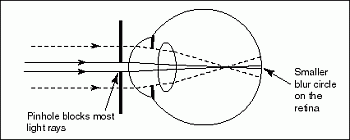 Referring to the figure and the representation of a pinhole in front of the eye: by the lens blocking the outermost rays and allowing only the central rays (solid lines) to pass into the eye, a refractive error in the eye’s lens or cornea is not as pronounced. In other words, the eye’s pupil may be wide open, but only its central portion is receiving light. The improvement in visual acuity in this case can be considerable. This principle, employed in Pin Hole glasses, is found in many other applications, including the well-known pinhole camera, used widely in photography in the past.
Referring to the figure and the representation of a pinhole in front of the eye: by the lens blocking the outermost rays and allowing only the central rays (solid lines) to pass into the eye, a refractive error in the eye’s lens or cornea is not as pronounced. In other words, the eye’s pupil may be wide open, but only its central portion is receiving light. The improvement in visual acuity in this case can be considerable. This principle, employed in Pin Hole glasses, is found in many other applications, including the well-known pinhole camera, used widely in photography in the past.
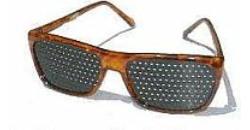 Pin Hole Glasses are considerably cheaper than prescription glasses. For example, a person who is slightly nearsighted but needs only a correction for clear distant vision for occasional TV viewing could find Pin Hole glasses a significantly cheaper solution than prescription glasses.
Pin Hole Glasses are considerably cheaper than prescription glasses. For example, a person who is slightly nearsighted but needs only a correction for clear distant vision for occasional TV viewing could find Pin Hole glasses a significantly cheaper solution than prescription glasses.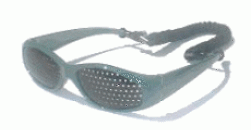 Even though using bifocals or reading glasses is a well-known technique for dealing with progressive myopia in kids, many parents won’t purchase bifocals or reading glasses for their children to reduce the stress of close work because such glasses are considered only for “old people.” Pin Hole Glasses are much cheaper than bifocals and can be more readily worn by kids because they are the same for all ages-and because they are “fun”!
Even though using bifocals or reading glasses is a well-known technique for dealing with progressive myopia in kids, many parents won’t purchase bifocals or reading glasses for their children to reduce the stress of close work because such glasses are considered only for “old people.” Pin Hole Glasses are much cheaper than bifocals and can be more readily worn by kids because they are the same for all ages-and because they are “fun”!